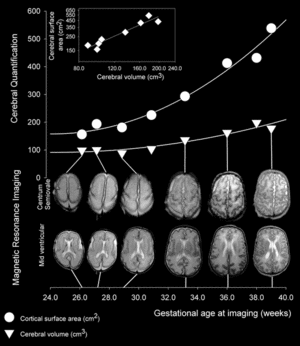Brain development

Brain development is the build-up of the central nervous system, starting with the embryonic ectodermal cells and transforming into the complex adult brain.
Various influences such as genetic transcription factors, mechanical tension due to axonal, synaptic and external forces and wiring optimisation principles shape the process, which progresses at highest speed during early embryonic development and decreases gradually until puberty. Considering lifelong plasticity, the process is however not complete with puberty. The initial steps include the formation of the neural plate from ectodermal cells, which then forms a groove and subsequently a tube. In humans, its anterior and posterior openings close around embryonic day 30 to form a basic, but complete entity: the most primitive predecessor of the human brain consisting entirely of neural stem cells.
The stem cells then start to divide into more and more complex neural and glial cells. These cells form into various layers and migrate from the locus of production to their final position. The migration of neurons is maximal in months 3-5 of gestation and guided by glial cells, which function as scaffolding. Over 100 molecules with specific functions are involved in the guiding process.
A further factor that might shape the paths the neurons take are tensions built up by forces arising from growing axons or adherence between synapses. The order of the final cell layers is such that the newly arriving neurons pass all already present neurons, so that the layers build up from the inside to the outside.
To date, adult neurogenesis in mammals has been demonstrated for specific cell types, by name neurons of the olfactory bulb and granule cells of the dentate gyrus. Other studies claiming the emergence of new neurons in adults suffer substantial methodological problems. Although the production of neurons from stem cells might be limited to a certain time window, brain development is still in its infancy when the neurons have emerged.
Once the neurons have reached their area of destination, the different areas begin to shape. One principle of cortical organisation is the optimisation of wiring costs. It predicts that neurons that interact frequently are more likely to be close together in space. Empirical evidence for this account stems from ocular dominance columns, where neurons receiving input from one eye assemble or from retinotopic maps that are ordered according to the visual space. Another process crucial for the functioning of the brain starts relatively late and continues until early adulthood: the myelinisation of axons. Myelinisation starts earliest in subcortical regions, develops in motor cortices earlier than in sensory cortices and reaches the prefrontal cortex last.
Structural Magnetic resonance imaging (MRI) has proven a useful tool to investigate the magnitude of myelinisation over time. MRI exploits the fact that the magnetic properties of different brain tissues are distinct from each other. It is thus for example possible to discriminate between the so-called grey matter consisting mainly of cell bodies and the white matter, consisting of the myelinated axons. The degree of myelinisation in certain brain areas has been correlated with specific cognitive and social-emotional skills, pointing to a possibly important role of white matter development on brain functions. Controlled longitudinal studies on the topic are however still pending.
The development of the brain is of course not purely guided by internal pre-programmed processes but highly influenced by experiences with the environment, particularly by learning and nutrition. Learning leads to stabilisation of frequently used wires and to the pruning, that is removal, of disused synapses. These changes through external influences are not restricted to the cortex. The response of the inferior colliculus (part of the brain stem) to speech sounds was shown to change in children even after the age of 2, whereas the response to clicks does not. This implies that through frequent linguistic input the firing patterns of the inferior colliculus are modified. The same could be shown for frequent musical experiences.